- The study on the effect of calcium chloride deicing agent and concrete compressive strength on scaling
Sung Hyun Eom*, Seong Soo Kim, Jeong Bae Lee and Seung Ho Park
Department of Civil Engineering, Daejin University, 1007 Hoguk-ro, Pocheon-si, 11159 Gyeonggi-Do, Republic of Korea
This experimental study
investigated the durability degradation of concrete exposed to freezing and
thawing and chloride intrusion. In order to observe the degree of the
degradation, 24 MPa, 35 MPa and 60 MPa concretes were used with 4% and 12%
calcium chloride solution as freezing water for scaling resistance and freeze -
thaw resistance tests. The results show that 24 MPa and 35 MPa concrete had a
relatively large decrease in durability due to the freeze-thaw resistance and
scaling resistance, but the 60 MPa concrete was not deteriorated significantly.
In addition, when the concentration of the solution of calcium chloride was 4%,
the degradation of durability was most remarkable. The results of this study
suggest when concrete structures such as bridges or roads expose to the
environmental conditions, appropriate measures such as increasing the designed
standard strength of concrete need to be deliberated and additional studies
should be conducted.
Keywords: chloride-based deicing agent, freezing and thawing, complex durability
In recent years, abnormal weather phenomena have been
occurring all over the world. The increase in precipitation in winter has
resulted in the heavy use of deicing salt in South Korea. During winter, a lot
of deicing agent are sprayed on the roads in order to prevent traffic
congestion and safety accidents when the snow
falls, or the temperature drops under 0 °C. However, it is known that a
large amount of deicing agent on concrete roads causes scaling and peeling on
road pavement surface like concrete near ocean, even though they are inland. In
addition, the use of chloride-containing deicing agent deteriorates the
degradation of performance with the repeated freeze-thaw cycles in winter. In practice, roads and structures
using a general performance concrete are constructed without
considering the complex effects of the use of the deicing salt with freeze-thaw
cycles. Thus, damage to concrete deteriorates the
concrete durability reducing its economic advantages due
to the shortened service life. In addition, the damage of
the concrete pavement causes traffic accidents resulting
in fatalities.
In order to prevent deterioration of concrete structures
caused by chloride-based deicing agent, studies have been conducted on
low-concentration chloride-based deicing agent and eco-friendly
deicing agent, suggesting measures to reduce the deterioration
of concrete [2].
As concrete structures are exposed to more diverse environment,
the performance standards for concrete have been stipulated by various
organizations so as to ensure a certain level of performance. In the case of
Expressway Construction Guide Specification of South Korea [3], various
specified concrete strengths (21 to 45 MPa) are suggested
according to the type of structure. The standard specification for concrete [4] and concrete structure
design code of South Korea [5], water - binder ratio
is specified as maximum 45% and minimum design reference
specified concrete strength is 30 MPa for concrete exposed to freeze - thaw or
deicing chemical in wet condition.
This study evaluated the durability of concrete subjected
concurrently to chloride-induced corrosion and freezing damage according to the
calcium chloride concentration using a high-strength concrete mixture and
concrete suggested in domestic and international specification regulations.
The physical properties and the chemical composition
of the ordinary portland cement are shown in Table 1. The deicing agent uses
the calcium chloride specified in ASTM C 672 [6] and the chemical composition
and properties are shown in Table 2. The aqueous solution of calcium chloride
was prepared at 4 and 12% used in the test.
The concrete selected in this
study was designed to be 24 MPa, 35 MPa, 60 MPa. Detailed concrete formulations are
shown in Table 3. The slump and air content are shown in Fig. 1. The slump is 100 ± 20 mm and the air content is 4.5 ± 1.5%. Compressive
strength and tensile strength were measured at 28 days, and the results are
shown in Fig. 2. As shown in Fig. 2, the compressive strength at 28 days is
close to the target compounding strength. Also, the flexural strength was about 17% of the compressive strength. The compressive strength and the flexural strength were measured
according to the method described in ASTM C 192 [7], and the compressive strength was measured
according to ASTM C 39 [8] after curing in water at 20 ± 2 °C for a period of time. The tensile strength was
measured according to ASTM C 1583 [9], and after the completion of the freezing-thaw resistance and scaling resistance test, a 50 × 100
mm core specimen was taken and its compressive
strength was examined. In order to investigate
the freezing and thawing resistance of calcium chloride deicing agent
environment, 4, 12% aqueous solution of calcium chloride was used as frozen
water. The test method was examined by the A TYPE test method of ASTM C 666
[10], and the relative dynamic modulus of elasticity
was measured for every 30 cycles, from -18 oC to -4 oC.
The scaling represented by the deterioration phenomenon of the
concrete surface in the repeated environment of salting, freezing and thawing
was studied. For this study, the amount of scaling was confirmed every 30
cycles using 0, 4 and 12% aqueous solution of calcium chloride as freezing
water according to the test method of ASTM C 672, and the freezing and thawing
repeated temperature was determined by A type test method of ASTM C 666.
Finally, to evaluate the penetration resistance of the
ions, NT Build 492 [11] was used as a test method of accelerated chloride
penetration as the chloride ion diffusion coefficient of concrete at the age of
28 day was compared.
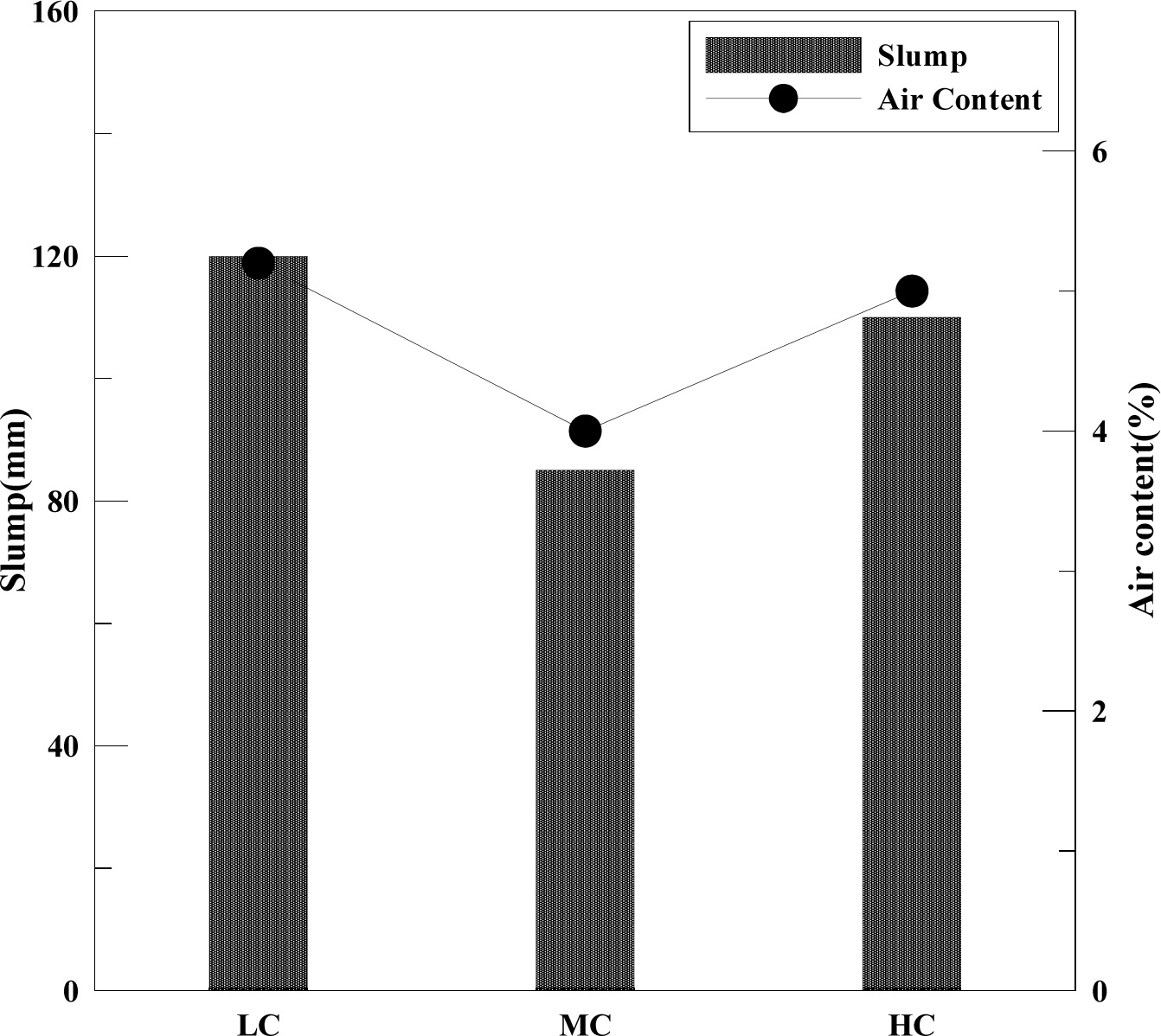
|
Fig. 1 Slump and air content. |
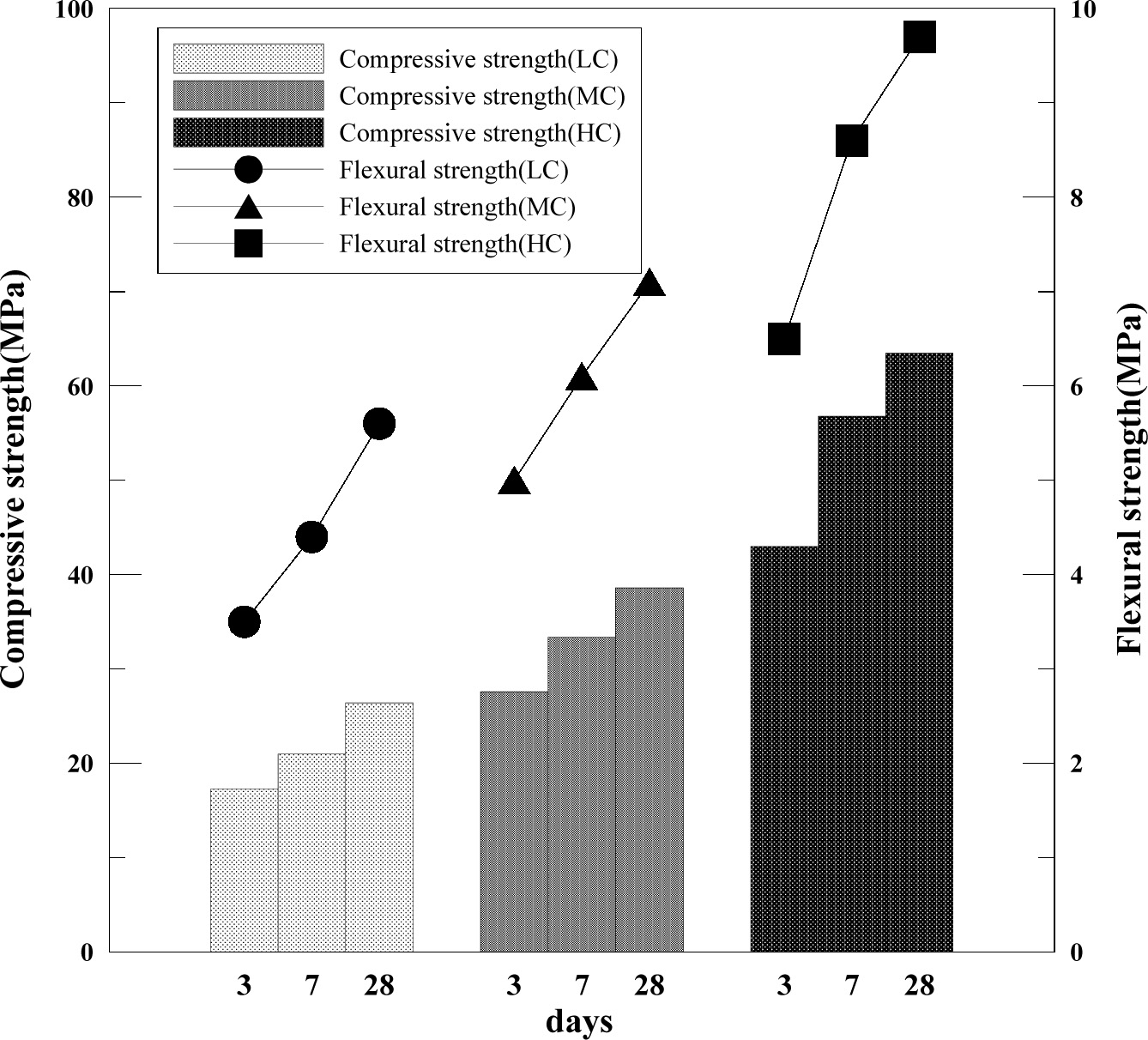
|
Fig. 2 Compressive and flexural strength. |
|
Table 1 Chemical composition and physical properties of ordinary Portland cement. |
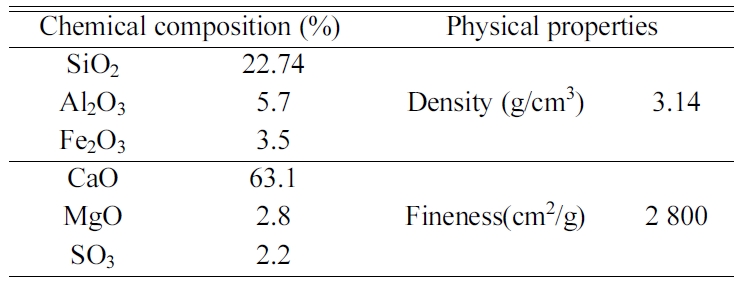
The freezing-thawing resistance is shown in Figs. 3 to 5.
As shown in Fig. 3 to 5, the LC displayed the lowest relative dynamic elastic
modulus ratio. The experiment using an aqueous solution of 4% calcium chloride
concentration to simulate a deicing agent had the lowest
relative dynamic elastic modulus as compared to
experiments that used ordinary water or an aqueous solution with calcium
chloride concentration of 12%.
Relative dynamic modulus elastic ratio is different depending
on the level of compressive strength. In detail, 59% lower
for LC and 40% lower for MC using the aqueous solution with the
calcium chloride concentration of 4%, It was confirmed that the
relative dynamic modulus ratio was decreased to less than 10% in all specimens
for HC, this is confirmed that the performance
deterioration due to freezing and thawing was not relatively large.
As the compressive strength increases, the resistance to
freezing and thawing was relatively high because the amount of internal surplus
water decreased when concrete was frozen because the water-cement ratio of
concrete decreased.
Another reason is that as the compressive strength
increases, the internal structure becomes dense. The pressure due to the
expansion of the freezing water is insignificant. In addition, it was difficult
to penetrate the aqueous solution of calcium chloride due to the closed matrix
of the concrete inside. Therefore, it is considered that the complex
deterioration effect of the freezing and thawing repetition, and salt corrosion
on concrete was not significant.
The experiment using an aqueous solution of 4% calcium
chloride concentration to simulate a deicing agent had the lowest relative
dynamic elastic modulus as compared to experiments that used ordinary water or an
aqueous solution with calcium chloride concentration of 12%. The
cause of such results may be because the 4% calcium
chloride concentration has a higher freezing temperature
than its 12% counterpart, leading to more active repetition of freezing and
thawing [12]. When freezing water is used as the water without using calcium
chloride, the freezing temperature is higher than that of using the deicing
agent, but the durability of the concrete was not deteriorated as much as
exposed to the deicing salt.
Therefore, when freezing water is used as the water with
using calcium chloride, it is considered that the ratio of relative dynamic
modulus of elastic was drastically reduced as the performance of concrete was
deteriorated by the combined effects of freeze-thawing and deicing salt damage.
Figs. 6 to 8 show the scaling amount of concrete specimens
measured every 30 cycles of freeze-thaw cycles. As shown in the figures, LC and
MC showed that the most scaling occurred when using an aqueous solution with a
calcium chloride concentration of 4%. It was confirmed that the HC, which is a
high strength concrete, remarkably reduces the amount of scaling compared to LC
and MC. Concrete with low water - cement ratio or high strength showed little
effect on scaling.
As a result of the concentration of aqueous solution of
calcium chloride, the amount of scaling was large in the case of using 4%
aqueous solution of calcium chloride as the freezing water, and the decrease in
strength was greatest at the end of the scaling test 46% for LC, and 13% for the high strength concrete HC. The
reason for this result is that the freezing temperature of 4%
aqueous solution was higher than the freezing water of 12% of calcium chloride
as in the results of the freezing and thawing resistance
tests [13]. As shown in Fig. 6, when the 4% aqueous solution of calcium
chloride was used as the freezing water, rapid scaling was observed between 120
and 150 cycles of freezing and thawing. It is considered that the scaling was accelerated
as the deterioration of the concrete performance was
accelerated by the complex effect of repeated
freeze-thaw cycles and the salt damage. Compared to LC the rapid
deterioration phenomenon was not observed in the case
of MC. However, the scaling tendency was the same as that of LC when the
calcium chloride 4% aqueous solution.
Fig. 9 shows the compressive strengths of all specimens
after accelerated scaling. The average compressive strengths of the specimens
were 38% for LC, 25% for MC and 12% for HC lowered. It demonstrates that when
the deterioration caused by freezing and thawing and scaling continues for a
long time, it would be difficult to secure the stability of the concrete
structure.
In this study, chloride ion diffusion test was performed
to evaluate chloride penetration resistance and
watertightness of ions and the durability of concrete by comparing
with scaling amount. As shown in Fig. 9, the chloride ion diffusion coefficient
and the scaling amount decreased rapidly with increasing compressive strength,
such as the chloride ion diffusion coefficient of 28 days and the scaling
amount measured after 300 cycles. The results may be due to the water-cement
ratio is high and the compressive strength is low, the concrete are not
densified, and the amount of pores distributed in the microstructure is large,
so that the chloride ions are easily diffused into the concrete, It is judged
that the deterioration due to scaling is increased. Fig. 4 Fig. 7 Fig. 10
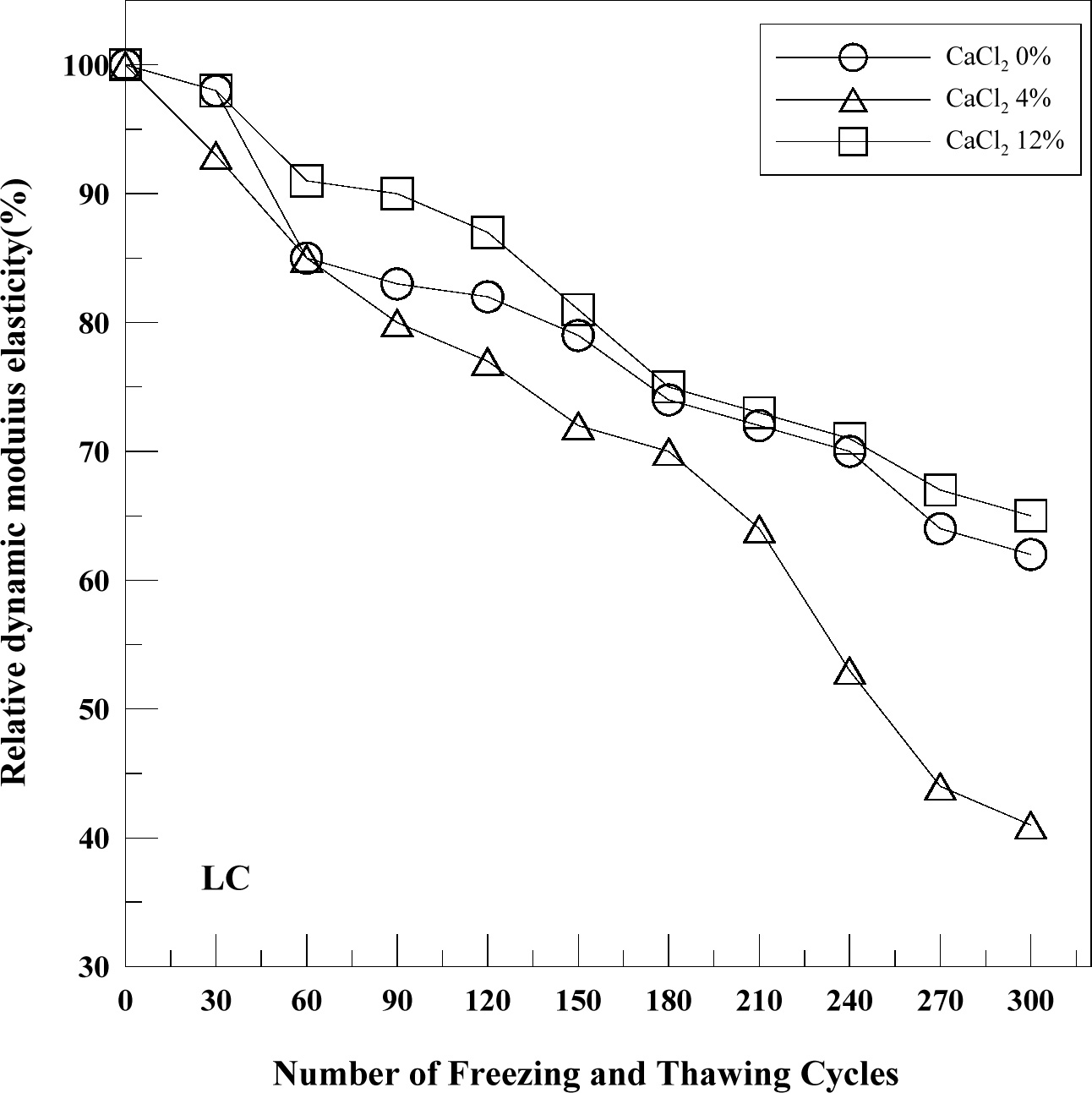
|
Fig. 3 Relative dynamic elastic modulus LC. |
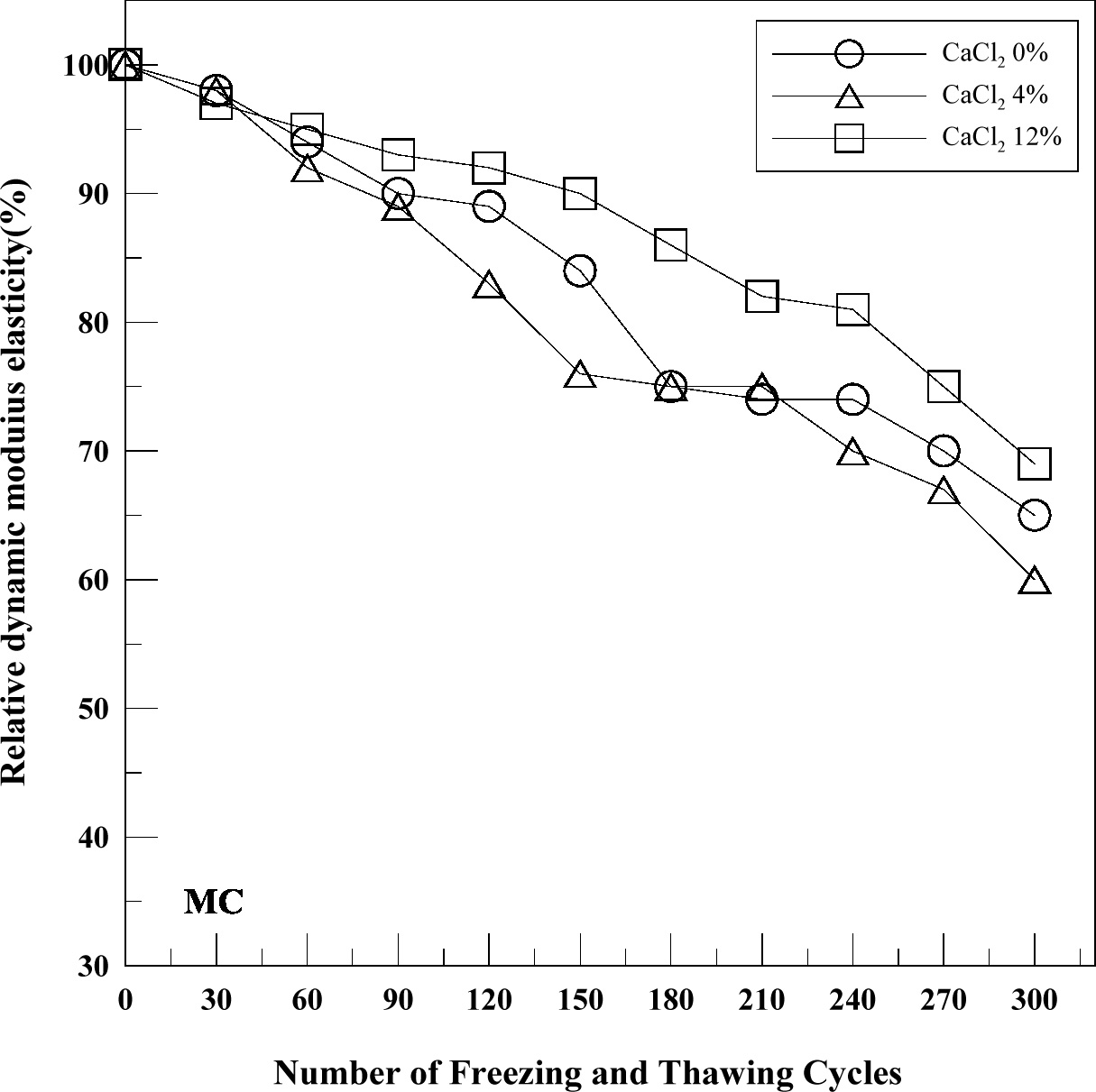
|
Fig. 4 Relative dynamic elastic modulus of MC. |
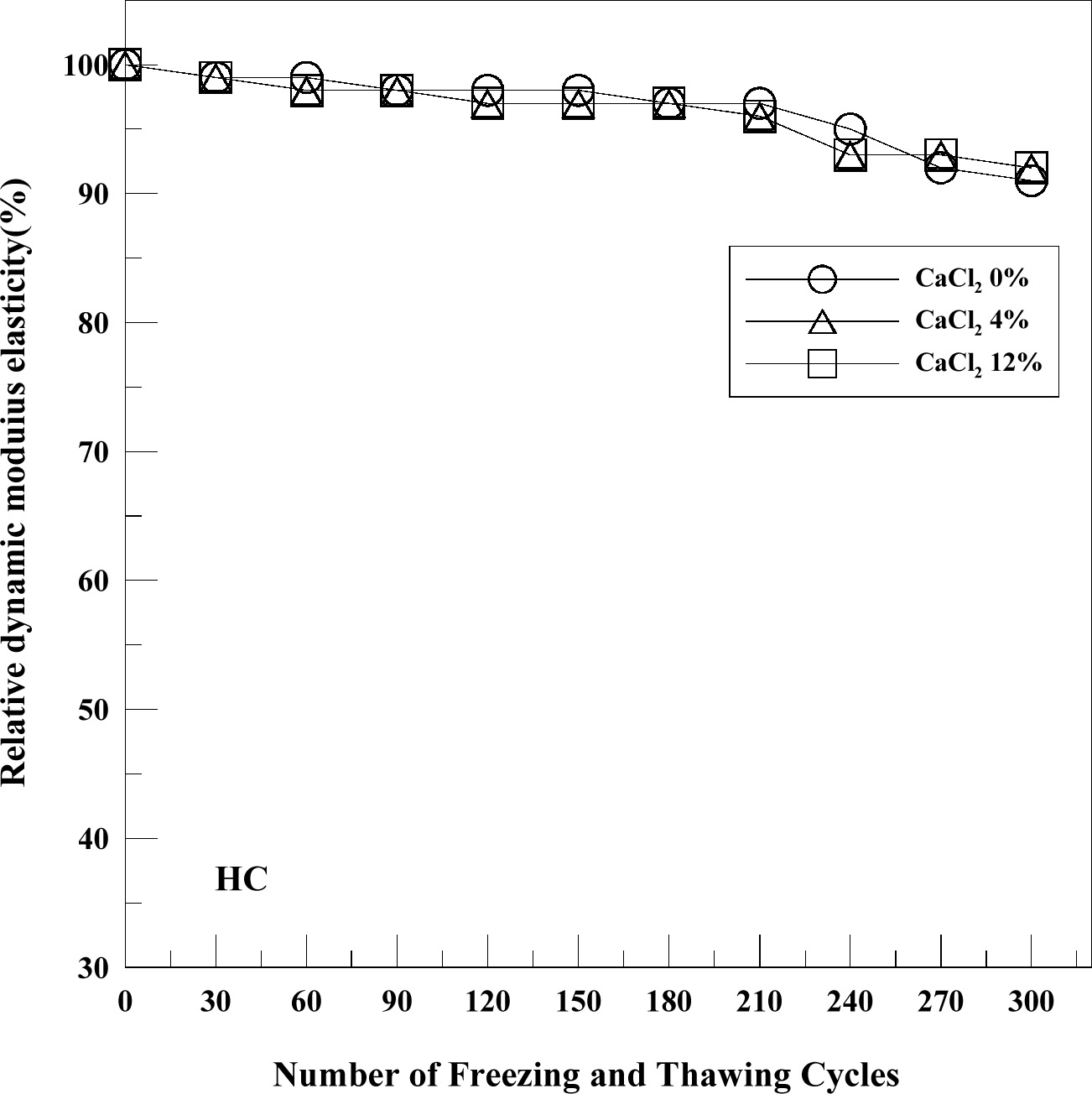
|
Fig. 5 Relative dynamic elastic modulus of HC. |
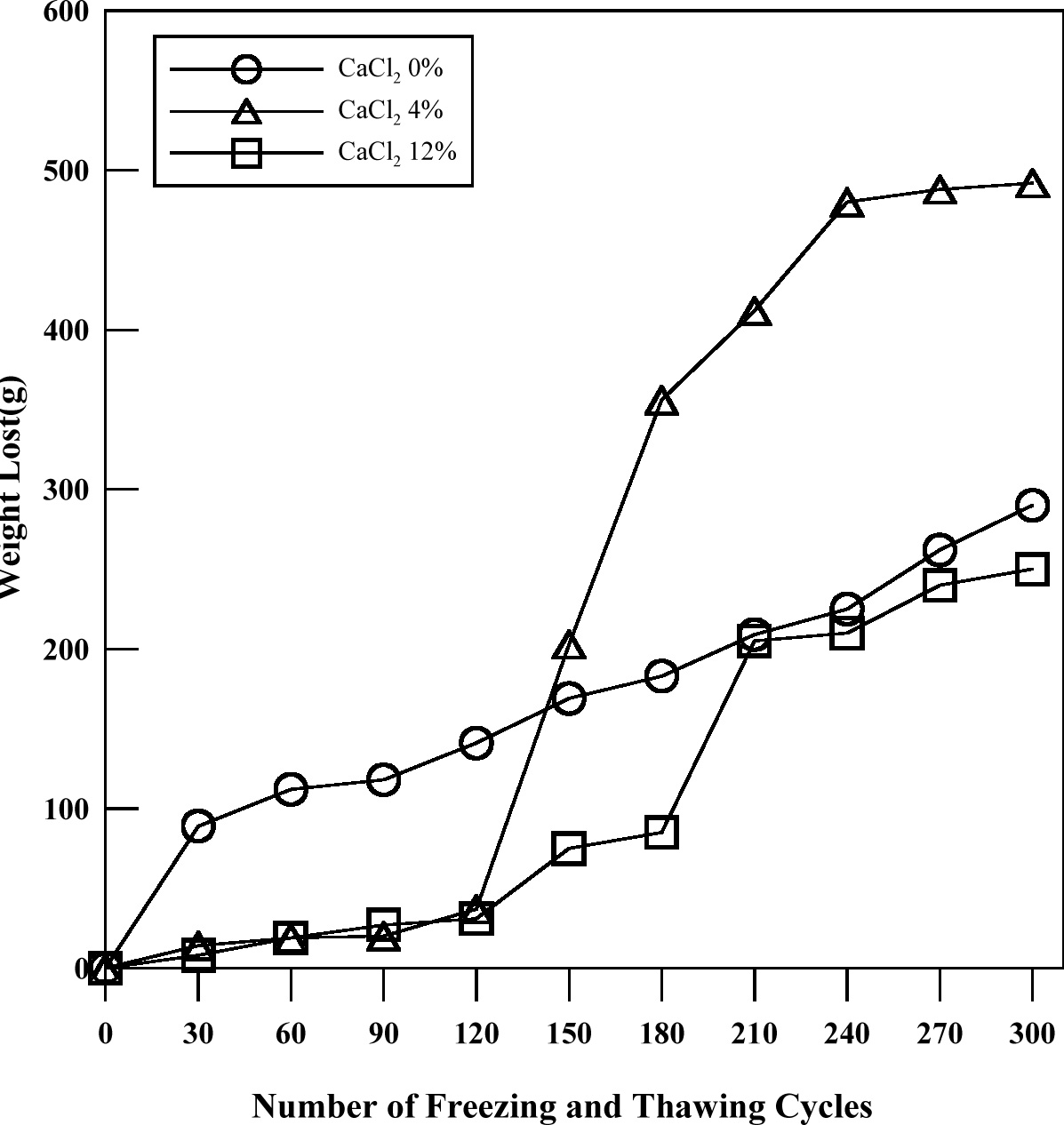
|
Fig. 6 Scaling of LC. |
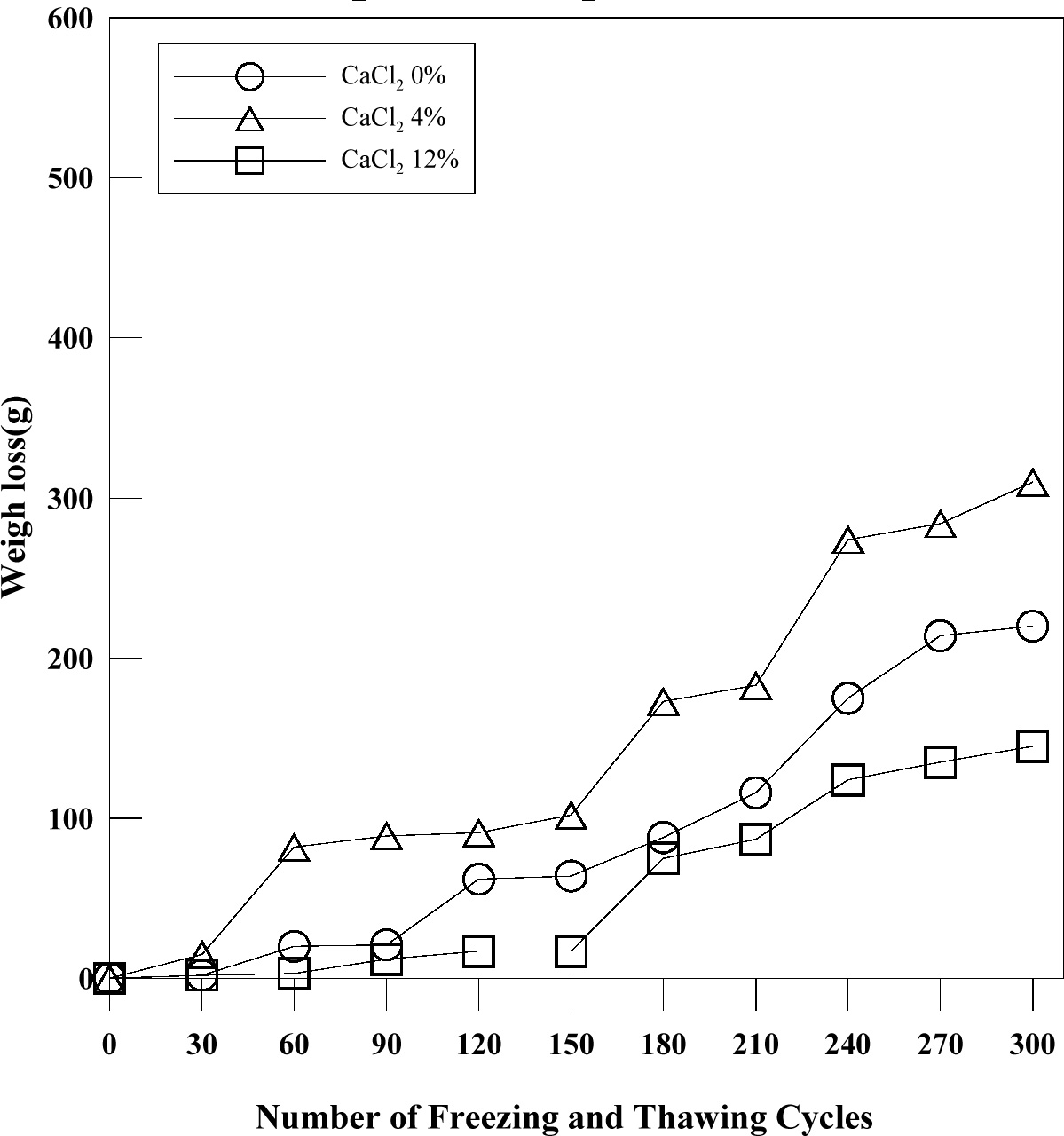
|
Fig. 7 Scaling of MC. |
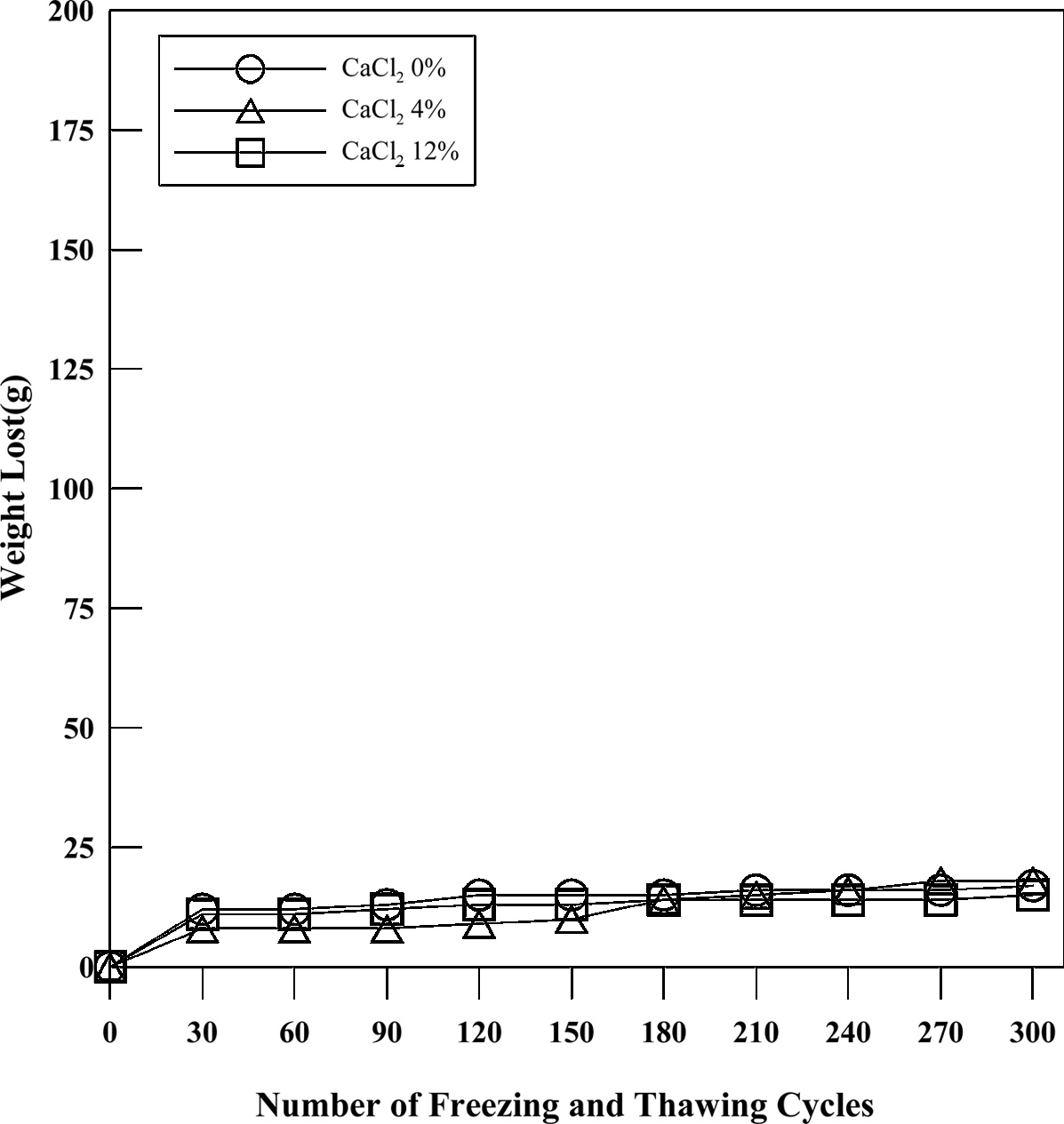
|
Fig. 8 Scaling of HC. |
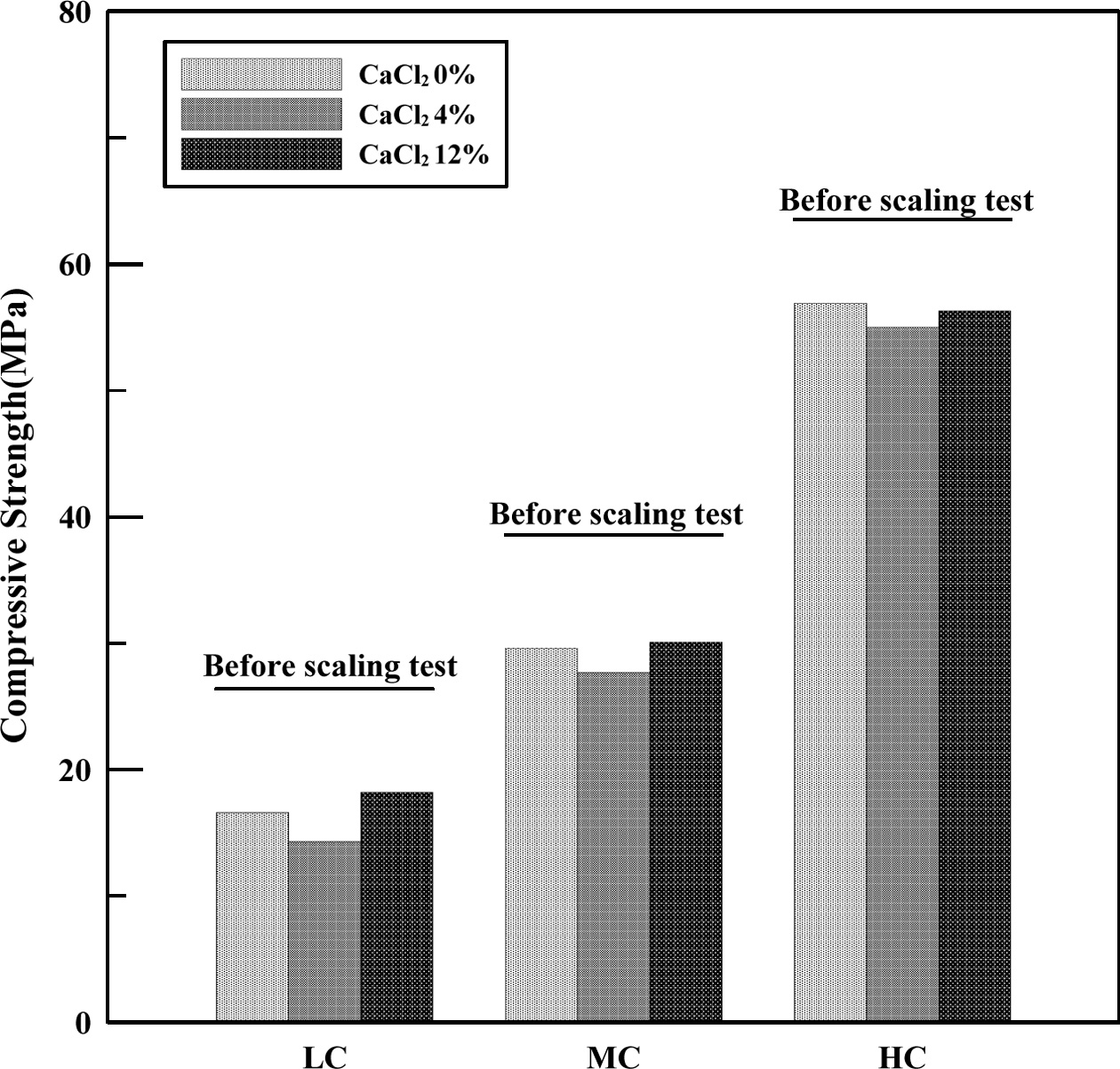
|
Fig. 9 Compressive strength after scaling 300 cycle. |
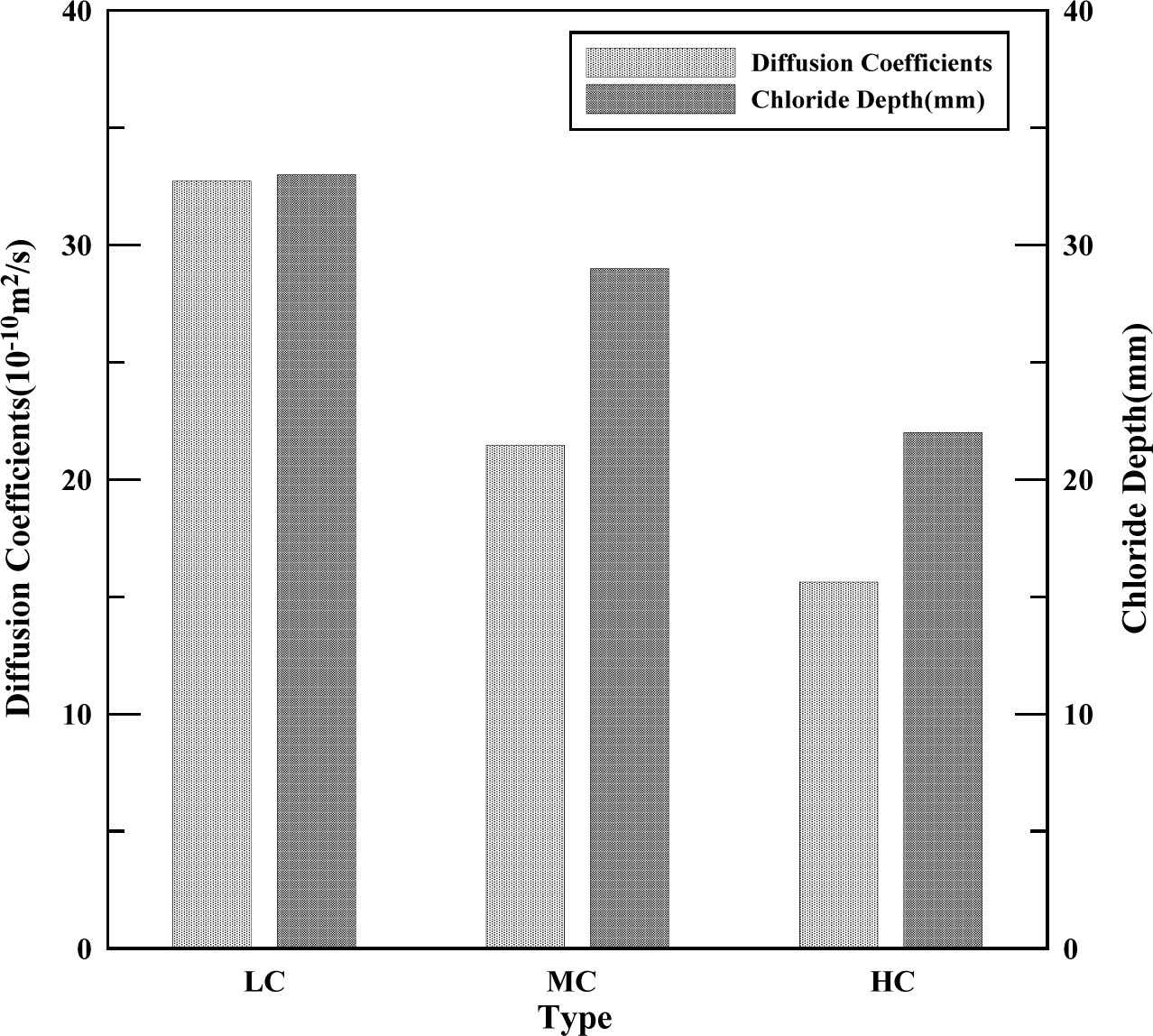
|
Fig. 10 Chloride ion diffusion coefficients. |
In this study, to investigate the durability degradation
of concrete in environmental conditions that simultaneously
receives salting and freezing and thawing, compressive strength of concrete was
classified into three types. Concrete performance deterioration by
calcium chloride deicing agent concentration was investigated and
the following conclusions were obtained.
1. In the freezing and thawing
resistance experiment conducted using an aqueous calcium chloride solution as
the deicing solution, performance loss was the greatest when the percentage of
calcium chloride in aqueous solution was 4%. Compressive Strength of 24 and 35
MPa Concrete showed a significant decrease in performance due to the
freeze-thawing and salt-smoothing effects. In the case of high-strength
concrete with a compressive strength of 60 MPa, the concrete strength was increased by maintaining the relative dynamic
modulus of 90%. It was confirmed that this method is effective for ensuring
durability.
2. As a result of the resistance
to scaling, it was confirmed that the scaling amount was the largest when using
4% aqueous solution of calcium chloride as freezing water
in all cases of LC, MC and HC. However, in the case of LC and MC, which are ordinary concrete, the degradation
of performance due to scaling is large and the performance degradation due to
scaling is relatively small in HC as a high-strength concrete.
3. As a result of measuring the
compressive strength of the core specimens collected from the scaling test
after 300 cycles of repeated exposure, the strength was lower when 4% aqueous
solution of calcium chloride was used as the freezing water
compared to water without calcium chloride or aqueous
solution with calcium chloride concentration of 12%. It was confirmed that the
strength was significantly lowered as compared with the case where 4% calcium
chloride solution was used as freezing water.
4. The relationship between
the chloride ion diffusion coefficient and the scaling amount of the concrete
was examined and it was confirmed that the scaling amount was increased with
the concrete having a high chloride ion diffusion coefficient. As the diffusion
coefficient of chlorine ion decreased and the compressive strength increased,
the decrease in the scale amount was larger, and it was judged that the
strength enhancement was effective in securing durability against freezing and
thawing and salting.
This work was supported by the Korea Institute of Energy
Technology Evaluation and Planning(KETEP) and the Ministry of Trade, Industry
& Energy(MOTIE) of the Republic of Korea (No. 20131020102300).
- 1. K.-B. Lee and S.-W. Lee, J. Korean Soc. Civ. Eng. 27[1D] (2007) 73-80.
- 2. B.-D. Lee, B.-S. Yun, J.-K. Lee, and Y.-H. Chung, Int. J. Highw. Eng. 7[4] (2005) 113-123.
- 3. Expressway Construction Guide Specification of Korea (Korea Expressway Corporation Press, 2012).
- 4. Standard Specification for Concrete of Korea (Korea Concrete Institute Press, 2009).
- 5. Concrete Structure Design Code of Korea (Korea Concrete Institute Press ,2012).
- 6. ASTM Standard, No. ASTM C 672 (2012).
-

- 7. ASTM Standard, No. ASTM C 192 (2019).
-

- 8. ASTM Standard, No. ASTM C 39 (2018).
-

- 9. ASTM Standard, No. ASTM C 1583 (2013).
-

- 10. ASTM Standard, No. ASTM C 666 (2015).
-

- 11. Nord test, NT BUILD 492 (1999).
- 12. degradation Research Committee report of concrete structures due to snow melting (Japan Concrete Institute Press, 1999).
- 13. Marchand. J, Pigeon. M, Bager. D, and Talbot. C, ACI Mater J. 96[4] (1999) 429-435.
-

 This Article
This Article
-
2020; 21(2): 164-169
Published on Apr 30, 2020
- 10.36410/jcpr.2020.21.2.164
- Received on Aug 5, 2019
- Revised on Mar 18, 2020
- Accepted on Mar 27, 2020
 Services
Services
- Abstract
introduction
material and methods
results and discussion
summary and conclusions
- Acknowledgements
- References
- Full Text PDF
Shared
 Correspondence to
Correspondence to
- Sung Hyun Eom
-
Department of Civil Engineering, Daejin University, 1007 Hoguk-ro, Pocheon-si, 11159 Gyeonggi-Do, Republic of Korea
Tel : +82-10-2032-6929 Fax: +82-31-533-9580 - E-mail: esh905e@naver.com








 Copyright 2019 International Orgranization for Ceramic Processing. All rights reserved.
Copyright 2019 International Orgranization for Ceramic Processing. All rights reserved.